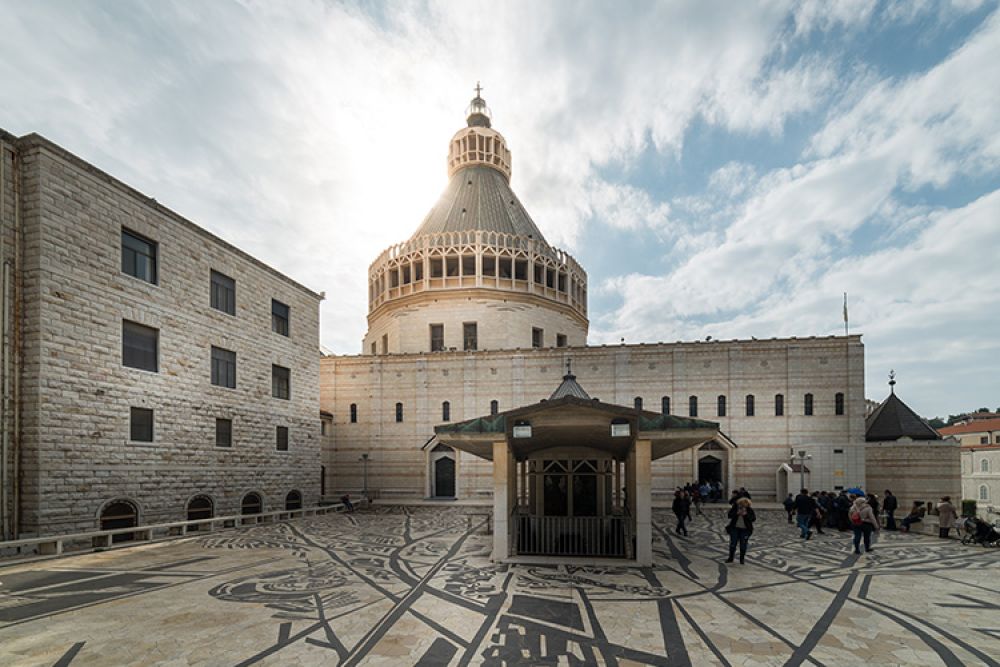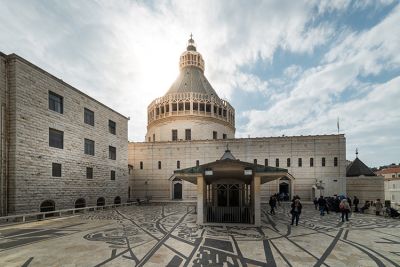

The guided tour of the Basilica of the Annunciation is a comprehensive experience that takes visitors through one of Christianity’s holiest sites. During the tour, participants will learn about the history and significance of the church which stands over the traditional site of the annunciation by the angel Gabriel to the Virgin Mary. The tour also offers insight into the stunning architecture of the modern basilica, completed in 1969, which is characterized by its vast size and the remarkable artworks that adorn its walls, donated by Catholic communities from all around the world. Visitors will have a chance to explore the lower level, which houses the grotto, the site of Mary’s home, and the remnants of churches from the Crusader and Byzantine eras.
Attending a Mass at the Basilica of the Annunciation is a spiritually enriching experience, irrespective of one's religious beliefs. The liturgy is often celebrated in the lower church, directly above what is believed to be the remains of Mary's childhood home. The ceremonies are conducted in several languages, catering to the international visitors and reflecting the universal nature of the Catholic Church. The sound of prayers, sermons, and sacred music within the domed basilica creates an ambiance that elevates the soul. Visitors are requested to dress modestly out of respect for the sacred nature of the site and the sanctity of the Mass. It is an opportunity for reflection, peace, and connection with the heritage of the place.
Exploring the Upper Basilica allows visitors to immerse themselves in a space filled with light and adorned with contemporary religious art that reflects the congregational and communal nature of worship in this space. The large, open area is ideal for personal reflection or prayer and features a central dome with an image of the Madonna and Child. Around the upper walls, visitors will see a collection of mosaics gifted from countries around the world, each depicting the Virgin Mary in a style that reflects the culture of the donating nation. The emphasis on art from a variety of cultures embodies the ecumenical emphasis of the site.
Photography buffs will find the Basilica of the Annunciation a haven for capturing stunning pictorial moments. The rich color contrasts, the intricate mosaics, artworks, and the impressive architectural elements of the Basilica present an array of opportunities for photographers. Participants can capture the interplay of light and shadow, the detailed iconography, and the devout attendees in quiet contemplation. A note of respect is paramount, as this is a place of worship, so appropriate silence and sensitivity to those praying should be maintained while engaging in photography.
Commemorated annually on March 25th, the Feast of the Annunciation is a particularly special time to visit the Basilica. It marks the announcement by the angel Gabriel to the Virgin Mary that she would bear the Son of God, Jesus Christ. On this day, the Basilica becomes a hub of religious activity, with special Masses, processions, and often a festive atmosphere that highlights the cultural importance of the event. Pilgrims from around the world travel to Nazareth to participate in the festivities, and the sense of community and shared devotion is palpable.
Participating in the evening prayer service at the Basilica of the Annunciation can be a tranquil ending to a day's exploration of Nazareth. As the sun sets, the Basilica is usually less crowded, offering a more intimate experience. Visitors can join the local congregation in the rhythmic chanting of prayers, surrounded by the soft glow of candlelight and the resonant sounds of choral and organ music that fill the expansive sanctuary. This activity invites a moment of personal introspection and spiritual connection amidst the historical and religious significance of the Basilica.
Travelers to Nazareth can engage in a day trip that not only takes them through the Basilica of the Annunciation but also to Nazareth Village, a re-created first-century village that offers an immersive look into the life and times of Jesus. The combination of visiting a modern place of worship and a historical reenactment site provides a multi-dimensional picture of religious heritage. After touring the Basilica and taking time to pray and reflect, visitors can head to Nazareth Village, where they can experience live demonstrations of ancient farming, hearth cooking, and crafts like weaving and pottery making.
Geared towards younger visitors, the Basilica of the Annunciation sometimes offers interactive workshops that educate children about the biblical story of the Annunciation and the importance of the Basilica. These workshops are designed to be engaging and informative, often including art and craft activities, storytelling, and simple explanations of the religious significance of the site. Children are given the opportunity to ask questions, participate in group learning experiences, and create their own souvenirs to take home, making it a memorable learning experience for families.
Visiting the Basilica of the Annunciation during the Christmas season offers pilgrims and tourists a chance to witness the site of the Annunciation in a festive atmosphere. With special decorations, lighting, and Nativity scenes set up, the Basilica and the surrounding area exude a holiday spirit. It's a special time to visit, as choirs and local communities perform carols and special services, and the air is filled with the anticipation and celebration of the birth of Christ. Visitors can also explore the Christmas markets in Nazareth, where local crafts, food, and gifts are on display.
The Basilica of the Annunciation is a sanctuary for those seeking a quiet place for personal meditation and prayer. Despite its significance as a tourist destination, there are areas within the church that provide a peaceful environment conducive to contemplation and spiritual solace. Visitors are welcome to sit in the pews, light a candle for a loved one, or simply rest in the silence of the sacred space. With the majestic surroundings and the sense of historical and spiritual depth, it is the perfect setting for personal reflection.
